Etude

En Bref
- Mobile banking penetration reached 80% in Hong Kong. Mobile is the most important channel for driving Net Promoter ScoreSM; however, branches have a higher likelihood to delight customers.
- Hong Kong consumers value smoothness, clarity, and privacy in their mobile banking apps, while mainland customers want “super app” functionality.
- We identified four key themes surrounding customer experience in digital retail banking. Customers want mobile-centricity, digital wealth management services, rewards, and compelling offers.
- As retail banking evolves, traditional banks must become more customer centric. Virtual banks need to focus on experience-driven, profitable growth at scale.
The retail banking market in Hong Kong
By nearly every metric, digital banking adoption has soared in Hong Kong since the Covid-19 pandemic.
The volume of Fast Payment System transactions almost tripled from 2019 to 2021, according to the Hong Kong Monetary Authority. Over an 18-month period from 2019 to the first half of 2021, the percentage of personal banking accounts opened via digital channels and the percentage of credit card applications completed online nearly doubled.
Consumers shifted their banking behaviors out of necessity but are staying with digital channels for the experience. That means online and mobile banking aren’t secondary channels or value-added services; they are the bank for an increasing number of Hong Kong consumers. Digital channels—and an impeccable digital experience—must attract, retain, and earn new customers.
To learn more about digital banking experiences and preferences, Bain & Company surveyed 1,400 retail banking consumers in Hong Kong in September 2022. We used the proprietary Net Promoter System℠ to measure customers’ experiences with traditional and virtual retail banks. Customers reported on multiple facets of experience, such as relationship (rNPS), channel (cNPS), product (pNPS), and episode. As part of the analysis, we classified respondents as brand “promoters” or “detractors.”
Companies that earn high NPS scores deliver great experiences, according to their customers, and that translates into quantifiable benefits. In this research, on average, promoters purchase 20% more product categories from their primary financial institution than detractors. Promoters are also more loyal customers (see Figure 1).
Promoters deliver more value to their primary financial institutions

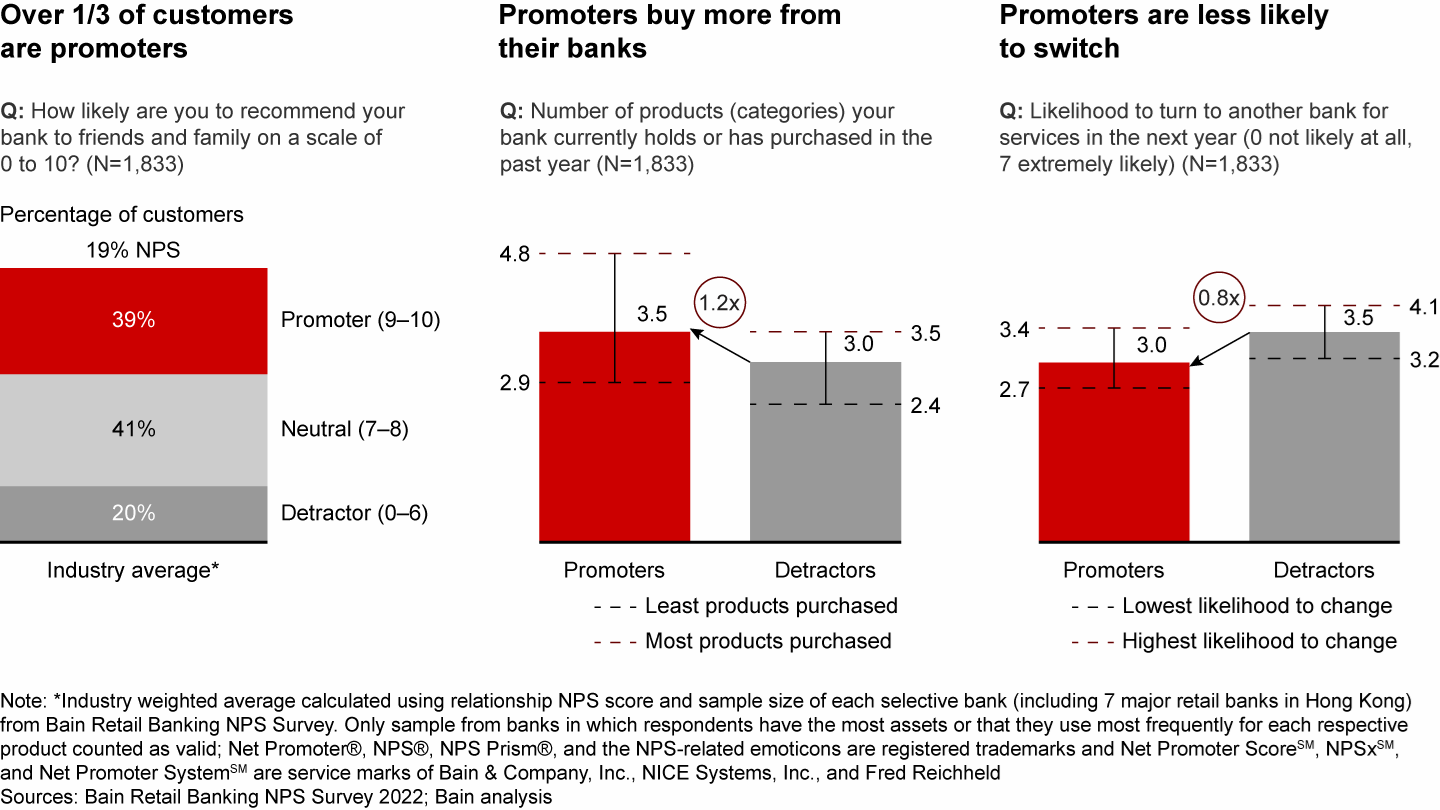
Our study covered seven major retail banks in Hong Kong. The average rNPS was 19, although there was a 17 percentage-point spread between the highest- and lowest-scoring institutions. The delta between the highest- and lowest-scoring institutions was even wider for other dimensions of NPS, such as channel (cNPS) and product (pNPS).
Those gaps are opportunities. Customer experience is paramount in and across every channel, especially as physical and digital channels blend. By focusing on customer experience, banks can create more economic value via higher lifetime customer values and lower customer acquisition costs.
What makes a digital retail banking experience delightful?
Our research identified four key themes surrounding customer experience in digital retail banking. Customers want mobile-centricity, digital wealth management, rewards, and compelling value propositions.
1. Customers want mobile-centricity and connected branch experiences
Over the past 12 months, mobile banking apps and online banking were the most-used channels, across different age groups and asset levels. Mobile banking penetration reached nearly 80%, while less than half of consumers stepped into a branch in the past year. On average, customers interacted with their bank via mobile slightly more than once per week. Customers with more investable assets used digital channels more frequently than the mass market.
Mobile banking experience had the highest correlation to positive overall customer experience, ahead of online banking and traditional channels. Hong Kong retail banking customers say they value a smooth mobile banking app, transparent terms and conditions, and robust privacy protection (see Figure 2).
Hong Kong consumers value smoothness, clarity, and privacy in their mobile banking apps while mainland customers want “super app” functionality

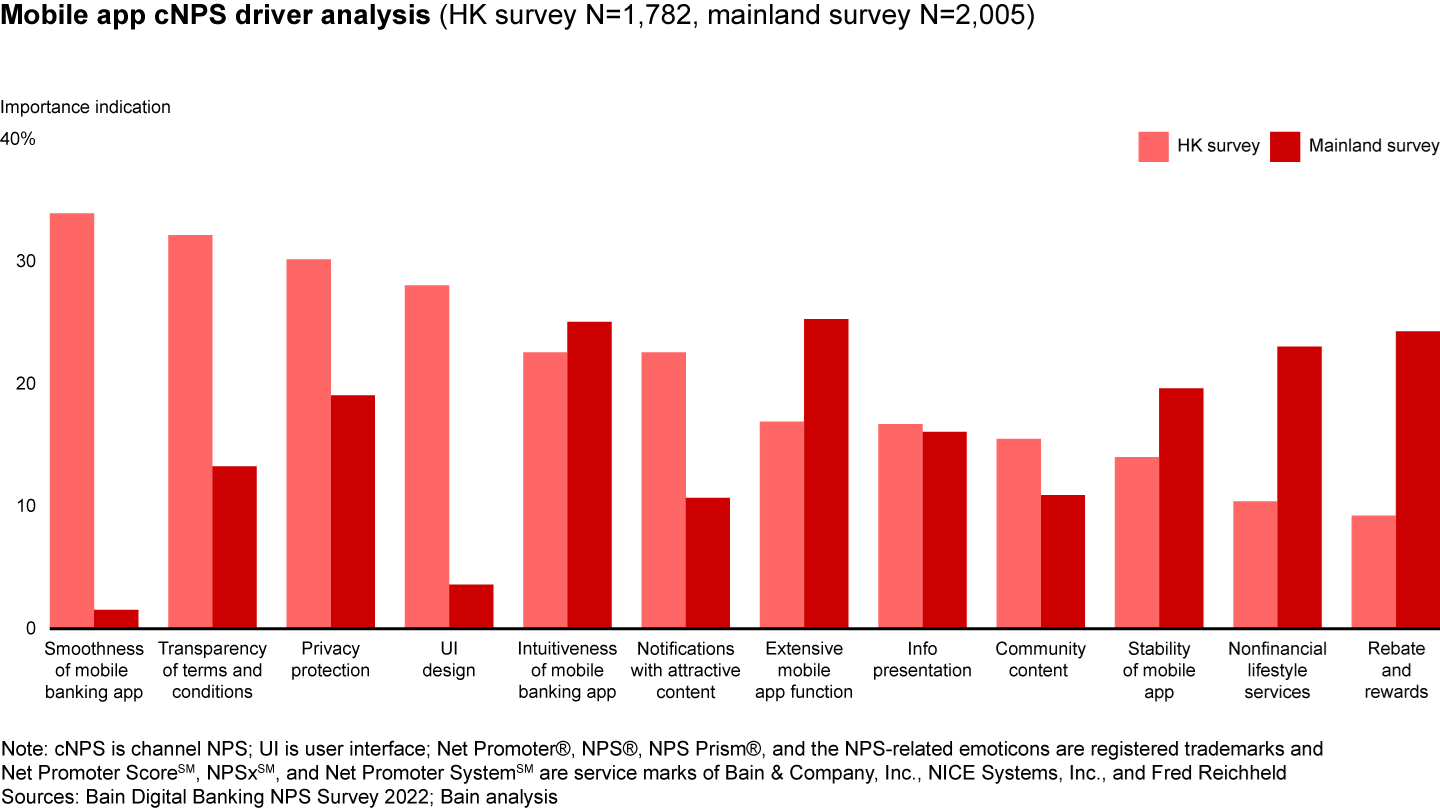
Extensive app functions and nonfinancial lifestyle features were less important to Hong Kong consumers, despite being attractive to customers in mainland China. Financial institutions that operate in both regions may need separate apps or customized solutions to address unique market preferences.
Despite customers only visiting branches once a month on average, branches have the highest chance of winning over customers—or pushing them away. “Customers value ‘human touch’ when dealing with complex or emotionally charged financial needs,” says Rannie Lee, head of wealth and personal banking at Hang Seng Bank. She says many customers still prefer in-person service for assistance with mortgage applications, wealth planning, and large international fund transfers. These so-called moments of truth can delight or disappoint customers and often define their overall relationship with or attitude toward a bank (see Figure 3).
Positive branch experiences can convert customers into promoters

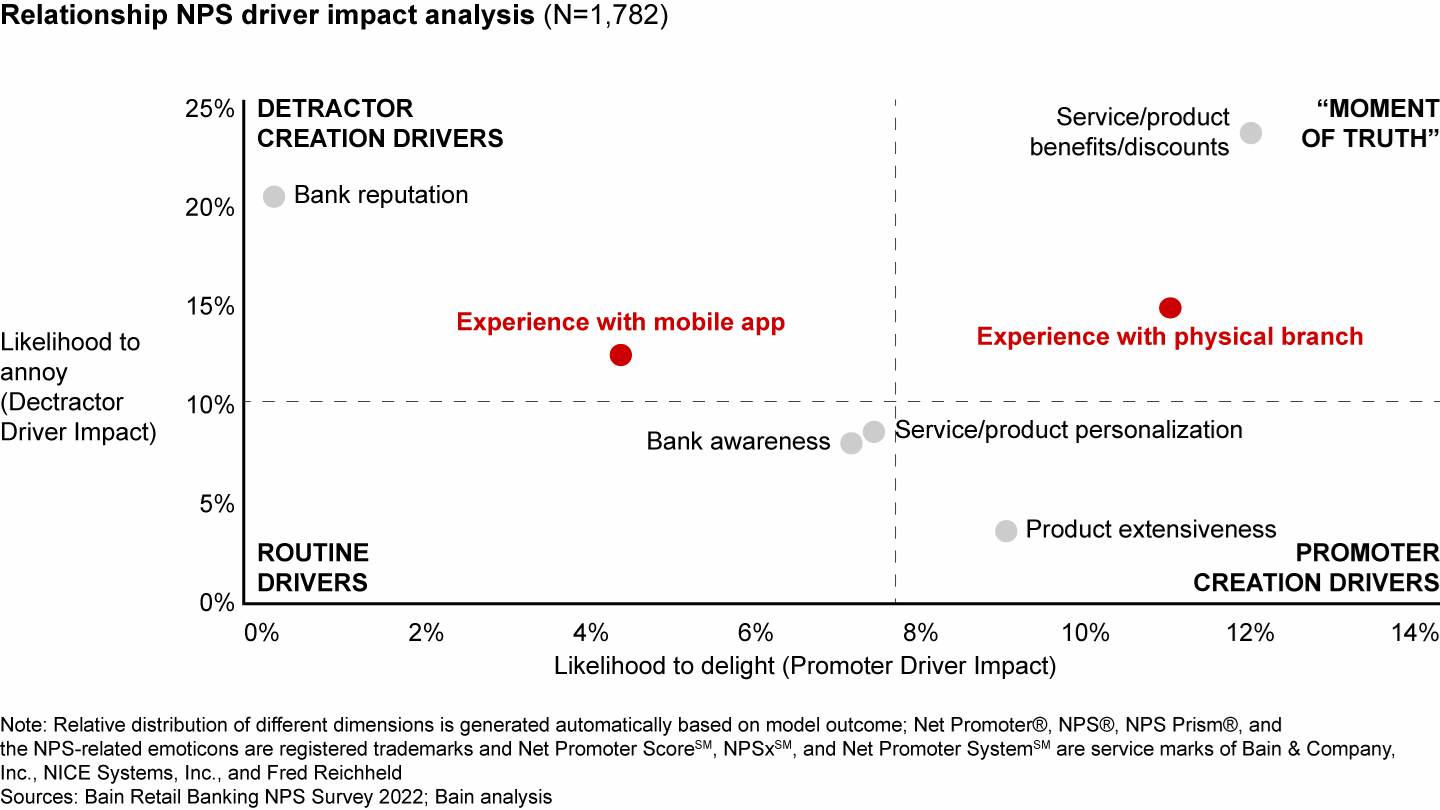
At the same time, Lee says younger and digitally savvy consumers don’t want to wait for counter service to sign paperwork in a branch. Physical locations need to provide on-site digital channels as part of a seamless omnichannel experience.
In the future, branches must evolve to become engagement- and experience-centered. That may mean smaller footprints, but deeper ties to digital channels.
2. Digital wealth management is taking off
Consumers are adopting digital banking products at different paces. Specifically, payments and consumer finance products have progressed quicker than wealth and insurance products.
However, many customers are ready to click “buy” on digital wealth and insurance products. We asked consumers how they purchased mutual funds and insurance last year. Of those who purchased from a bank, 45% of mutual funds and 40% of life insurance policies (by value) were purchased through their bank’s mobile app.
Major banks and fintechs are already offering digital wealth management services to the market. AQUMON rolled out “robo-advisor as a service” to help financial institutions build customized investment strategies for their clients. “Our sweet spot is serving ‘long tail’ customers that traditional human advisory services cannot cover,” says Kelvin Lei, founder and CEO of AQUMON. Digital capabilities such as these allow financial institutions to bring investment advisory solutions to the mass market.
Digital tools are integral to the customer journey, but so is human support. And most customer journeys cross multiple channels. Even though 75% of respondents completed their mutual fund customer journey digitally, almost 10% needed human support for part of the process. Moving forward, a digital-human approach is the best model for retail wealth management.
The balance of human touch vs. digital will vary by customer segment and phase of the journey (see Figure 4). For example, major banks could offer human-delivered services to their most affluent consumers in any stage of the journey or channel, but use digital self-services or robo-advisory solutions for the mass market.
Wealth management services will blend digital and human touch, based on segment

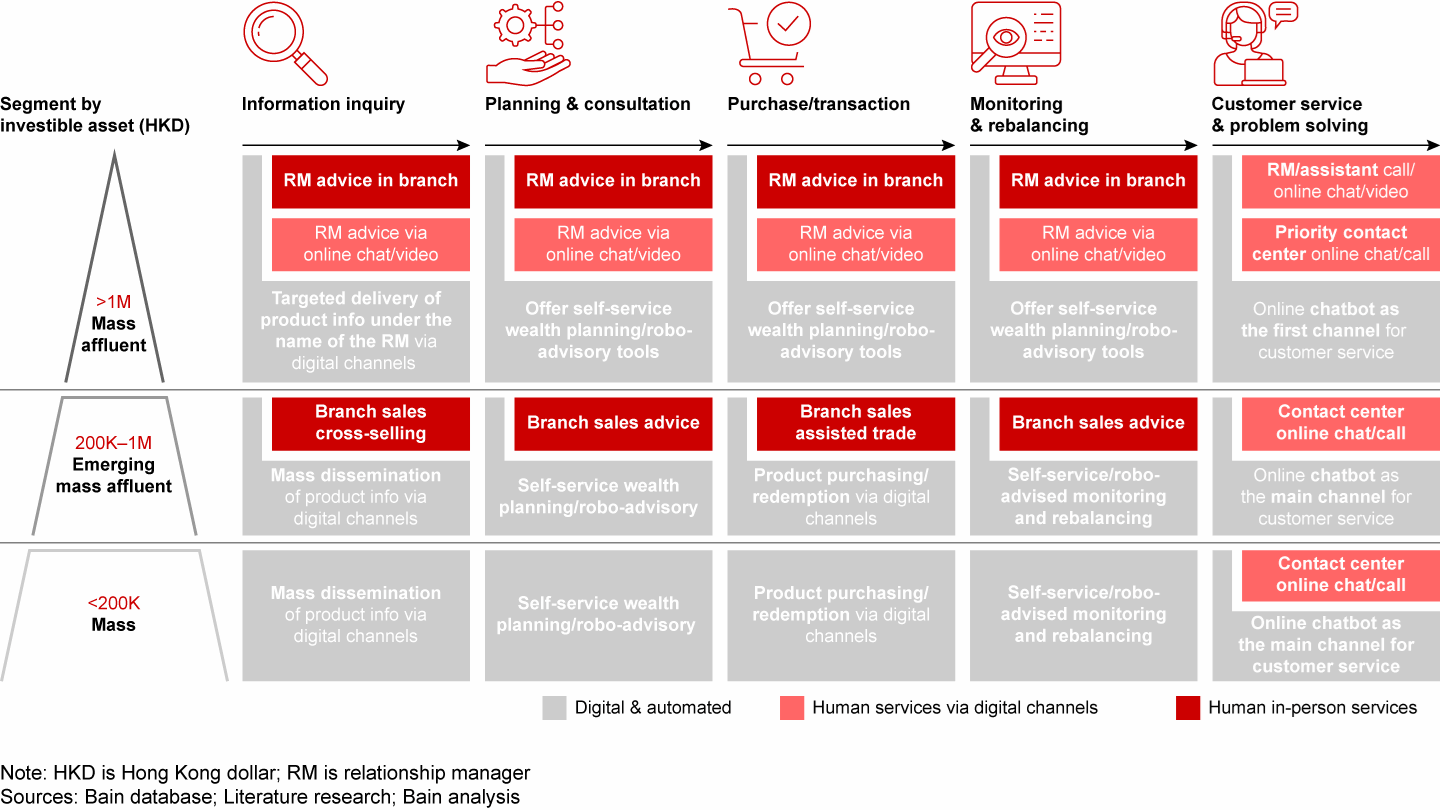
Under an omnichannel service model, high-touch human services can transition into blended interactions. Financial consultation can start in a branch with a relationship manager, then move to texts or video calls through a secured platform on the bank’s mobile app, explains Dick Ho, deputy general manager at Bank of China Hong Kong (BOCHK). At BOCHK, financial consultations can be initiated by video calls through the mobile app or through traditional face-to-face meetings in a branch.
More players will launch and expand their digital wealth management services in the coming years, hoping to ride the market boom. It’s important for banks to get their strategy and customer experience right. As more customers become comfortable managing their wealth online, the rate of adoption will accelerate. The sector is ready to take off.
3. Benefits and rewards delight customers
In Hong Kong, customers say attractive rewards lead to great experiences. Benefits and discounts are the top rNPS drivers, ahead of channel experience, product range, and bank reputation.
We analyzed how customers ranked nonbanking mobile app features, from news feeds to health trackers and chatbots. Reward features have the highest likelihood to delight customers when offered, or to annoy customers if absent (see Figure 5). Customers appreciate all forms of rewards—vouchers, instant cash back, points—and find them similarly attractive.
Customers value rewards and benefits the most among all nonfinancial services features on mobile apps

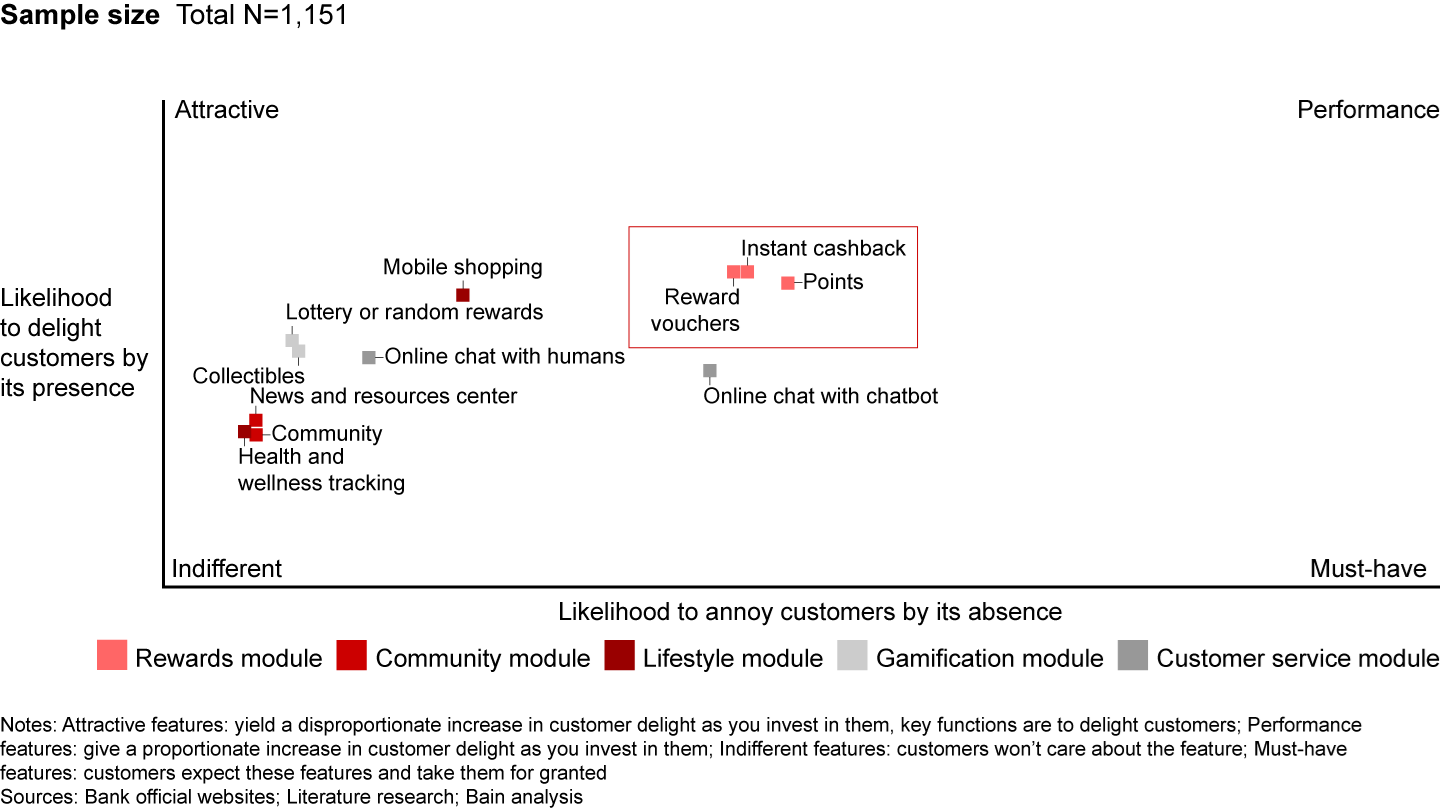
Customer service modules like chatbots are expected, must-have functions. But some features, such as health and wellness trackers or user communities, have little effect on attracting customers.
To drive engagement, ZA Bank combines rewards and gamification on its mobile app. By spending with their ZA card, customers are entitled to rewards, including chances to win HKD$1 million in cash. Customers click on “PowerDraw” in the bank’s app to claim their offers.
“Gamification allows us to continuously enhance user engagement,” says Calvin Ng, ZA Bank’s alternate chief executive. “It is definitely a win-win. We can understand users’ behavior while they get to know more about our products. We value every moment to delight our users and deepen the relationship.”
4. Virtual banks are creating innovative and attractive value propositions
Since launching in 2020, eight virtual banks have opened more than 1.5 million new accounts. That’s an impressive number for a city with a population of 7.4 million.
How did virtual banks attract new customers so quickly? First and foremost, they offered attractive new customer rewards and referral incentives. Those tactics were highly effective because Hong Kong customers value rewards.
Virtual banks also offered unique (and often stronger) value propositions and were laser-focused on customer experience. Compared to some traditional banks, virtual banks offer faster loan approvals, lower interest rates, more flexible repayment terms, and easier-to-use platforms for consumer finance products.
WeLab Bank Chief Executive Tat Lee thinks personalized advisory services can help differentiate virtual banks. Although lending is a relatively “plain vanilla product,” he says, virtual banks can provide services that help customers get better financing plans. WeLab Bank uses data intelligence to offer speedy and customized financial solutions.
Lending has been a boon for virtual banks. Loan volume shot up around 380% CAGR from 2020 to 2021. Despite the exponential growth, there’s still upside potential. Among all virtual banks in Hong Kong, the total loan book was only HKD$11.2 billion by midyear 2022, compared with an overall consumer finance market of HKD$683 billion.
Virtual banks also outperformed traditional banks in customer experience in specific product areas, according to the NPS ratings. For consumer loans, the average pNPS for the eight virtual banks we studied was 52%, which was significantly higher than the average for traditional banks (20%).
To keep the momentum going, virtual banks should continue to create attractive value propositions, expand their product offerings, and build reputable brands.
By focusing on customer experience, many virtual banks have established a virtuous cycle to earn business—and the flywheel is taking off. Social and digital marketing, distinctive branding, compelling offers, and competitive pricing draw customers in. Those customers are rewarded with engaging and stress-free experiences that plug directly into their lifestyle and other services they use. Then, word of mouth, referrals, and repeat customers help virtual banks grow further (see Figure 6).
Customer experience is a flywheel for virtual banks to attract, retain, and grow customers

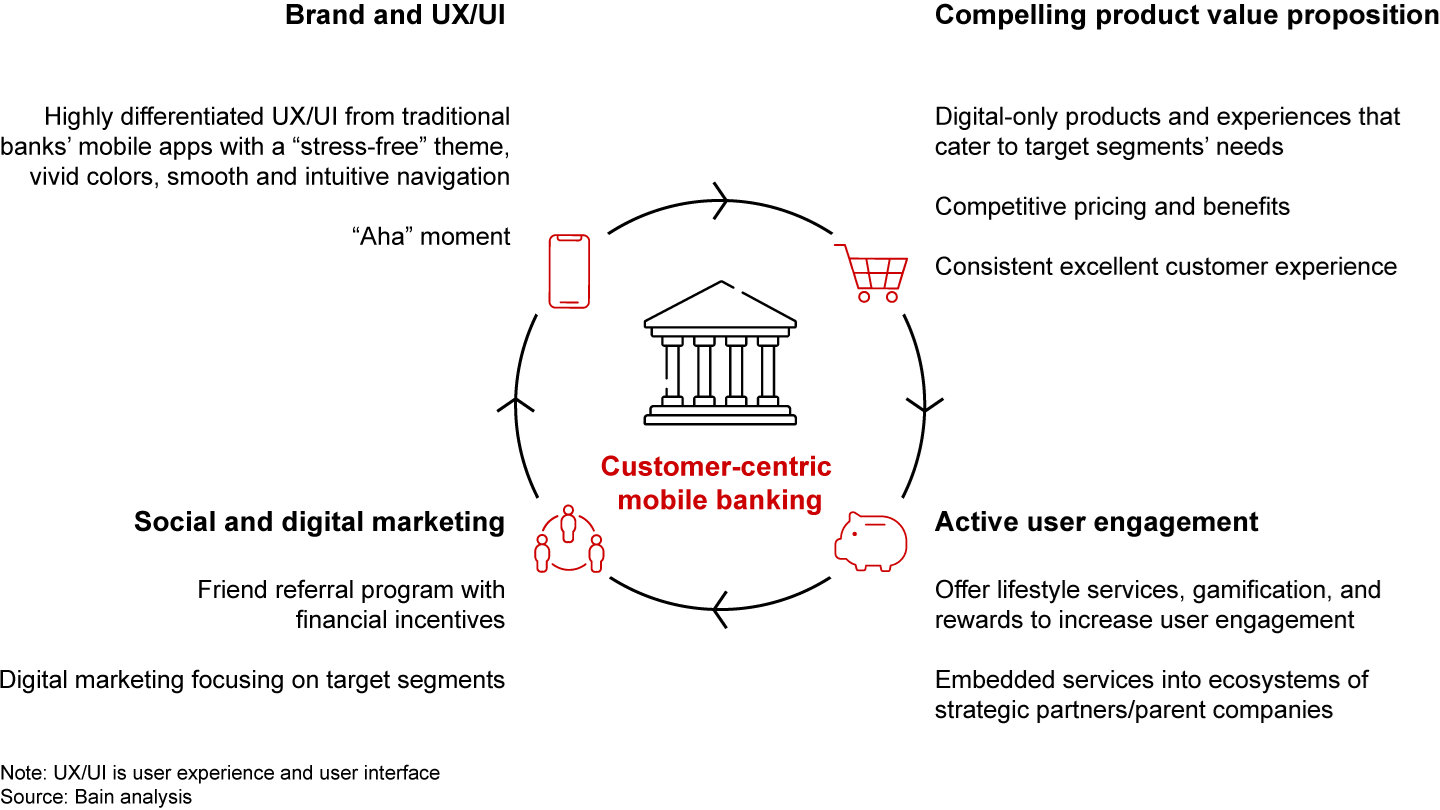
Offering attractive rewards and incentives gave virtual banks a strong start, but at a high cost. Now, virtual banks are gradually shifting their focus from bought growth to earned growth to achieve critical scale and improve their bottom lines.
Right now, most virtual banks’ products are relatively simple, which reinforces ease of use. To expand and become profitable, virtual banks must explore new products and verticals without complicating the process. To deliver delightful customer experiences, banks should keep mobile app navigation intuitive and “stress free,” even as products and services become more complex.
Virtual banks need accurate customer insights and ways to evaluate new product launches. Livi tests concepts and ideas with a group of 200 targeted customers (Livi Circle) before launching any new products, according to Carol Hung, Livi’s alternate chief executive and chief product officer. “After launch, we closely monitor every step of the customer journey so we can collect feedback and improve,” she says. Livi also closely tracks customer sentiment through NPS surveys and competitive benchmarking.
Embedding finance into everyday life
To be delightful, banking experiences need to be seamless for users. Virtual banks may need ecosystem partners (or parent companies) to help them embed banking services into other platforms that customers regularly use.
Ant Bank (Hong Kong) leveraged a partnership with mobile wallet provider AlipayHK to create a mini-app inside the digital payments platform. It allows users to open a high-yield savings account and make payments to local merchants through the e-wallet. Customers can also link their savings accounts to the AlipayHK platform for online and offline payments. “The experience is convenient and seamless, so we don’t need to spend much effort pushing customers to use our services,” says Yvonne Leung, chief executive of Ant Bank.
Connecting into other platforms is also a priority for Fusion Bank, according to Chief Technology Officer Flying Wu. Fusion Bank embedded its services into different payment scenarios and gained access to merchants through its parent company, Tencent.
Traditional banks are also active in embedded finance. “Embedding non-financial or partner services into the banking experience must add value for customers. It needs to make sense and complement their existing lifestyle,” says Kim Lay, head of digital banking at Hang Seng Bank. For example, partnering with a dining platform could make it easier for credit card customers to manage reservations, rewards, and payments through a seamless process.
Key actions for traditional banks
Virtual banks changed the dynamics of retail banking in Hong Kong and, to some extent, redefined how financial institutions deliver value. Both traditional and virtual banks must focus relentlessly on customers and pursue the best value propositions possible. How they deliver value—the customer experience—will set them apart.
Traditional banks have long-standing relationships and deep customer knowledge to their advantage, but they face more organizational, system, and capability challenges as they transform into customer-centric players. There are three stages of development that traditional banks can follow to improve customer experience (see Figure 7). The starting point may vary based on how sophisticated and customer-centric a bank is today.
Banks can become more customer-centric in three stages

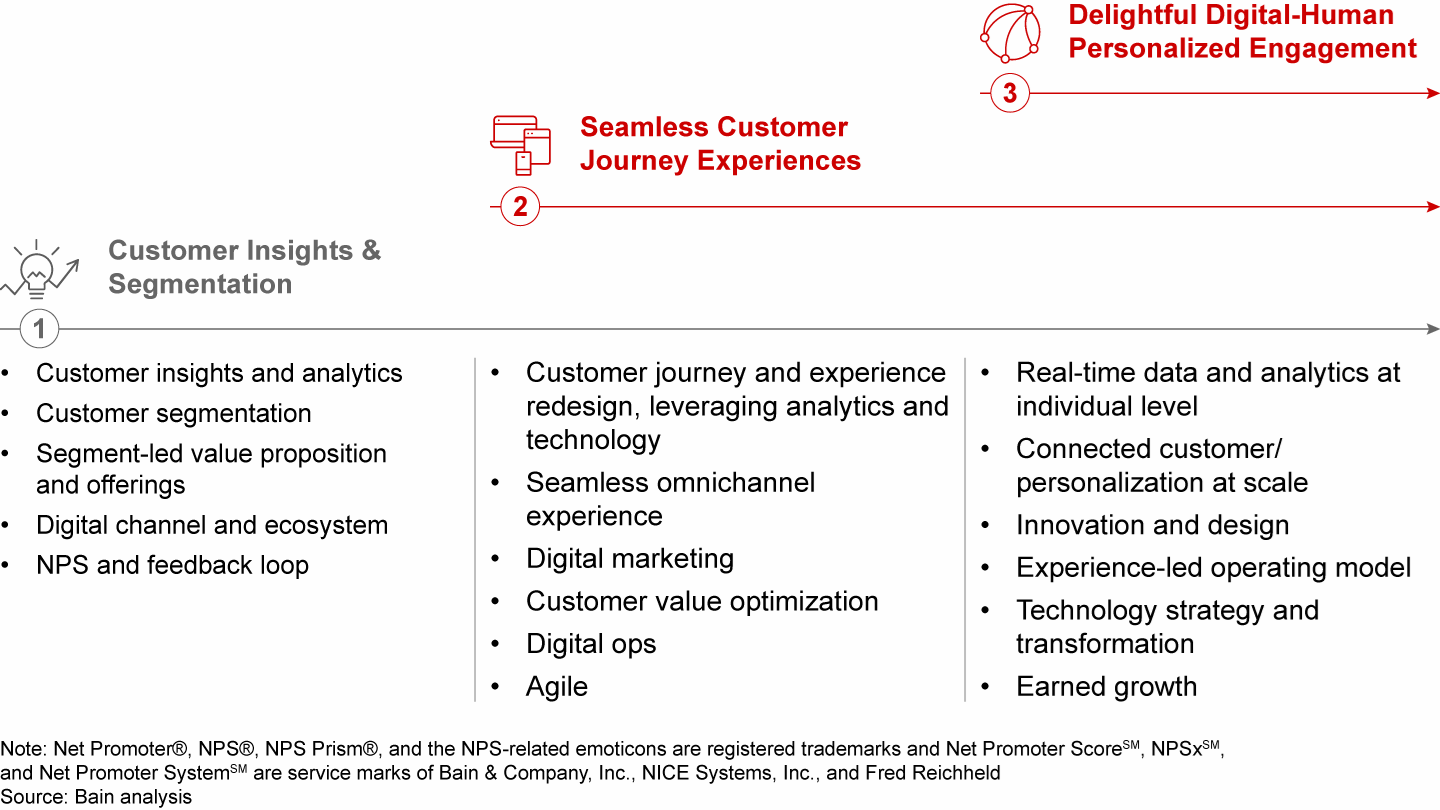
Stage 1: Develop segment-based customer insights and propositions
In this phase, banks need to build core capabilities in customer insights and analytics to understand their position in the market. Examine the bank’s culture, strategy, and performance benchmarks to identify gaps and opportunities. Use all available data to establish your position, ideal customer segments, and segment-led value propositions. From there, digital channels and the ecosystem needed to deliver value will come into focus.
Research and analysis are not “one and done” events. Use measures such as NPS to continually collect feedback and adapt the customer experience strategy.
Stage 2: Create a seamless customer journey
Next, apply customer insights to create seamless, omnichannel customer journeys. Start with products or performance areas with the highest potential to affect NPS scores, such as mobile wealth management. Create a customer experience roadmap to identify priority use cases, then determine how and when to scale technologies.
Remember, technology isn’t supposed to digitize the traditional banking process. Rather, it’s intended to enhance the experience and value for customers. Continuous feedback loops and sentiment monitoring can keep development efforts on the right track.
Stage 3: Optimize digital and human engagements
By leveraging advanced data analytics, banks can blend digital and human engagements to create ultra-personal interactions and delight customers.
Real-time data and analytics can be applied at the individual level, whether customers are at the counter or on a mobile device. To achieve personalization at scale, traditional banks need experience-led operating models and customer-driven cultures. Some banks may also need to upgrade their data and IT infrastructure to support more advanced customer experience capabilities.
As the dimensions of customer experience become more complex, traditional banks will need new ways to measure customer relationships across products, channels, and journeys. Continual, higher-velocity feedback loops will be necessary to benchmark performance, make timely and effective decisions, and “win on purpose.”
Lay offers an example in which Hang Seng’s accelerated customer feedback cycle helped the bank identify and resolve an issue with a system upgrade more quickly. “We picked up on the drop in NPS within a week and swiftly implemented corrective actions,” says Lay. “Responding quickly and effectively to customer feedback is central to maintaining trust.”
Customer-based accounting can help traditional banks measure earned growth that results from customer experience. Combined, customer-based accounting and dynamic sentiment tracking (such as NPS or NPS Prism℠) can help traditional banks create delightful experiences.
Key actions for virtual banks
After a two-year period of rapid growth, virtual banks are under pressure to become profitable. Under the current macro environment, investors are increasingly risk averse and focused on pathways to profitability over “growth at all cost.”
The eight digital-native banks we studied are pursuing different development paths (e.g., products, customer segments, personal vs. business banking). Will they steal a sizeable share of the market away from traditional banks? Or will they remain specialists, only winning certain customers and product niches? The jury is still out. But to succeed in the next stage of development, virtual banks must take three critical steps.
Step 1: Focus on the path to profitability
Every virtual bank has to take profitability seriously. To break even, the basic formula is to achieve high-enough scale at a low-enough unit cost. Virtual banks should revisit their unit economics, since costs and complexity may have accumulated during periods of rapid growth.
Management should also determine and track sources of the bank’s growth and categorize them as “earned” or “bought.” From there, leaders can ruthlessly prioritize strategies that drive profitable growth (e.g., the right segments or customers who will buy more from them).
Advanced analytics are key to this step. Use analytics to optimize marketing activities and spending so they are directed toward the highest impact and returns on investment.
Step 2: Introduce products that enhance customer experience and lifetime value
Selectively introduce new products, focusing only on those that increase customer lifetime value and NPS. Every new product has to be a blockbuster that enhances customer experience.
To do that, virtual banks should leverage immersive customer insights. Listen to customers to identify in-demand products and go-to-market strategies. Stay focused on addressing unmet customer needs and strengthening the bank’s value proposition. Use strict financial discipline and track operational key performance indicators in real time to issue timely responses as customer needs and sentiments change.
Step 3: Achieve experience-driven, profitable growth at scale
Ultimately, success is about delivering superior customer experiences at scale. Virtual banks can leverage real-time customer data and advanced analytics to deliver personalization at the individual level (e.g., recommending the best consumer finance plan at the time of need). They can also leverage high-velocity customer NPS feedback loops to refine the customer experience.
Growing profitable business at scale should be a strategic priority. Products with favorable margins and high customer advocacy will help virtual banks achieve economies of scale more quickly.
Finally, efficient technology and operating platforms can lower operating costs and create competitive advantages over traditional banks. Virtual banks can turn the flywheel into a true profit engine.
Conclusion
Digital acceleration has paved the way for a new and exciting era of retail banking in Hong Kong.
Without the burden of legacy technology and processes, fintechs and virtual banks can be more nimble and innovative. Traditional banks are also leveraging digital technology to play both defense and offense. What’s the right strategy for your bank?
Ask your customers.
Customers are the best source for feedback, opportunities, and sustainable growth. Banks that delight customers—on any channel—will find exciting ways to grow.